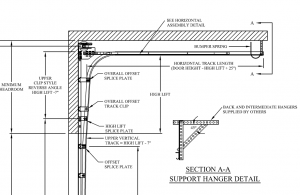How to Properly Insulate Between Roof Purlins
Efficient climate control is becoming the buzz term for post frame construction. A challenge occurs when clients look to insulate between their roof purlins.
Reader JOHN in COVINGTON writes:
“I am building an all wood pole building. The purlins are 2x8s. I want to insulate the walls and up at the purlins to keep as much usable space as possible with an insulated building. How do I insulate and properly vent between the insulation and the underside of the plywood roof underlayment. If I use R19 it is 6 inches so there would be 2 inches of space between the insulation and the wood. Do I use something like a house bird block at each end of the building for each purlin space?”
Mike the Pole Barn Guru Writes:
The best solution lies in creating an unvented roof
It is quite possible to design an unvented insulated roof assembly which performs well, as long as you get the details right. In recent years, most building codes have begun to allow the construction of unvented insulated sloped roof assemblies. Many such roofs have failed over the years, however, so don’t get creative. Follow the rules.
For sake of brevity, I will limit this discussion to only as it pertains to post frame buildings with widely spaced trusses and purlins on edge.
First of all, you can’t use air-permeable insulation (for example, fiberglass batts, mineral wool batts, dense-packed cellulose, or blown-in fiberglass) to insulate an unvented roof assembly unless the roof assembly also includes a layer of air-impermeable insulation (spray polyurethane foam) directly below the roof steel or sheathing.
 The 2009 IRC (International Residential Code) defines air-impermeable insulation as “an insulation having an air permeance equal to or less than 0.02 L/s-m² at 75 Pa pressure differential tested according to ASTM E 2178 or E 283.” Although spray foam insulation and rigid foam insulation meet this standard, fiberglass batts and dense-packed cellulose do not.
The 2009 IRC (International Residential Code) defines air-impermeable insulation as “an insulation having an air permeance equal to or less than 0.02 L/s-m² at 75 Pa pressure differential tested according to ASTM E 2178 or E 283.” Although spray foam insulation and rigid foam insulation meet this standard, fiberglass batts and dense-packed cellulose do not.
If you want to use just one type of insulation in unvented bays, you are limited to spray polyurethane foam. Another possibility, of course, is to build your roof with structural insulated panels (SIPs), which in most cases is cost prohibitive.
The code restrictions on the use of air-permeable insulation between purlins were developed to prevent the purlins or roof sheathing from rotting. When fiberglass batts are installed in unvented bays, the batts allow moist indoor air to reach the cold steel roofing or sheathing. That leads to condensation or moisture accumulation, followed eventually by rot. Since spray foam prevents air movement, it almost eliminates this problem.
It’s important to note, however, recent research suggests closed-cell spray foam is much less risky than open-cell spray foam in this location.
To summarize, there are really two practical ways to build an unvented roof assembly:
Install closed-cell spray foam against the underside of the steel roofing or roof sheathing, and no other type of insulation. Be sure the thickness of the spray foam is adequate to meet minimum code requirements. Remember open-cell spray foam is risky in all climate zones, and if open-cell spray foam is installed in this location in a cold climate, the underside of the cured foam must be covered with gypsum drywall which has been painted with vapor-retarder paint. Vapor-retarder paint is ineffective if it is sprayed directly on the cured foam.
Install a layer of closed-cell spray foam against the underside of the steel roofing or roof sheathing, and fill the rest of the purlin cavity with an air-permeable insulation. This type of assembly is designed to dry to the interior, so the assembly should never include an interior polyethylene vapor barrier.








What happens if you had put Foil on foil double bubble on first and then the closed foam insulation?
Secondly what will happen if a screw backs out and you get a leak? Where will the water go?
You could have some adherence issues between the reflective radiant barrier and the spray foam. Screws do not “back out” if they are properly installed. If you get a leak it is due to the screw not being properly seated, or driven in at an angle. In your instance, a leak would mean water sitting between the radiant barrier and the roof steel – not an ideal situation.
I have a contractor installing a new tin roof on top of galvanized purlins and he was suppose to put the foil insulation that comes in a roll between the roof and purlins, well he forgot tot do so, so now what do I do.
Two inches of closed cell spray foam insulation will be your best solution.
Can I use closed cell foil faced 4×8 panels on the underside of the purlins? I have a ridge vent & soffit vents. Inside of roof decking has a felt coating. Wondering if the channels in the underside of decking will cool the airspace & deck? Barn is 32×40 with 12’ side walls……
It does not sound like an overly practical solution, I would be much more inclined to put in a ceiling and blow in fiberglass on top of it.